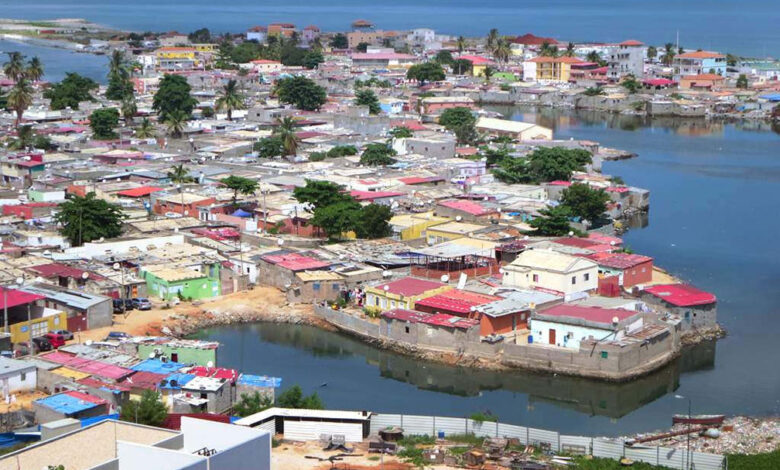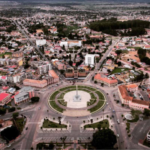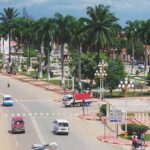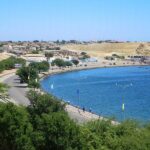Luanda

Luanda is the capital and largest city in Angola. It is Angola’s primary port, and its major industrial, cultural and urban centre. Located on Angola‘s northern Atlantic coast, Luanda is Angola’s administrative centre, its chief seaport, and also the capital of the Luanda Province. Luanda and its metropolitan area is the most populous Portuguese-speaking capital city in the world and the most populous Lusophone city outside Brazil, with over 8.3 million inhabitants in 2020.
The city was founded as São Paulo da Assunção de Loanda (St. Paul de Loanda) by the Portuguese explorer Paulo Dias de Novais in 1575. The port city served as the centre of the Portuguese slave trade until the beginning of the 19th century.
The population of Luanda has exploded in recent years, about one-third of Angola’s population lives in Luanda, and the city has a population of more than 5 million inhabitants. 50% of its residents live in poverty but Luanda is the world’s most expensive city for expatriates, according to Mercer’s 2011 ‘Cost of Living Survey’. The city won the somewhat dubious accolade for the second year.
Luanda is currently undergoing a major reconstruction, with many large developments taking place which will alter the cityscape significantly.
Coordinates: 8°50′18″S 13°14′4″E / 8.83833°S 13.23444°E / -8.83833; 13.23444 Province Luanda • Capital city 116 km (45 sq mi) • Metro 1,876 km (724 sq mi) • Capital city 2,571,861 • Metro 8,330,000 • Metro density 4,400/km (12,000/sq mi)
Climate
Luanda has a hot semi-arid climate (Köppen: BSh), bordering upon a hot desert climate (BWh). The climate is warm to hot but surprisingly dry, owing to the cool Benguela Current, which prevents moisture from easily condensing into rain. Frequent fog prevents temperatures from falling at night even during the completely dry months from May to October. Luanda has an annual rainfall of 405 millimetres (15.9 in), but the variability is among the highest in the world, with a coefficient of variation above 40 percent. The climate is largely influenced by the offshore Benguela current. The current gives the city a surprisingly low humidity despite its low latitude, which makes the hotter months considerably more bearable than similar cities in Western/Central Africa. Observed records since 1858 range from 55 millimetres (2.2 in) in 1958 to 851 millimetres (33.5 in) in 1916. The short rainy season in March and April depends on a northerly counter current bringing moisture to the city: it has been shown clearly that weakness in the Benguela Current can increase rainfall about sixfold compared with years when that current is strong.
Demographics
The inhabitants of Luanda are primarily members of African ethnic groups, mainly Ambundu, Ovimbundu, and Bakongo. The official and most widely used language is Portuguese, although several Bantu languages are also used, chiefly Kimbundu, Umbundu, and Kikongo.
The population of Luanda has grown dramatically in recent years, due in large part to war-time migration to the city, which is safe compared to the rest of the country. In 2006, however, Luanda saw an increase in violent crime, particularly in the shanty towns that surround the colonial urban core.
There is a sizable minority population of European origin, especially Portuguese (about 260,000), as well as Brazilians. In recent years, mainly since the mid-2000s, immigration from Portugal has increased due to greater opportunities present in Angola’s booming economy. There is a sprinkling of immigrants from other African countries as well, including a small expatriate South African community. A small number of people of Luanda are of mixed race — European/Portuguese and native African. Over the last decades, a significant Chinese community has formed, as has a much smaller Vietnamese community.
Places of worship
Among the places of worship, several are predominantly Christian churches and temples:
- Roman Catholic Archdiocese of Luanda (Catholic Church)
- Evangelical Congregational Church in Angola (World Communion of Reformed Churches)
- Evangelical Reformed Church in Angola (World Communion of Reformed Churches)
- Baptist Convention of Angola (Baptist World Alliance)
- Universal Church of the Kingdom of God
- Assemblies of God.
Luanda – Culture
As the economic and political centre of Angola, Luanda is similarly the epicentre of Angolan culture. The city is home to numerous cultural institutions, including the Sindika Dokolo Foundation.
The city hosts the annual Luanda International Jazz Festival, since 2009.
The city is home to numerous museums, including:
- National Museum of Anthropology
- National Museum of Natural History
- Museum of the Armed Forces
- National Museum of Slavery
Other monuments in the city include:
- Palácio de Ferro
- Fortress of São Miguel
- Fortress of São Francisco do Penedo
- Luanda Cathedral
- Igreja de Jesus
- Igreja da Nossa Senhora do Cabo
- Igreja da Nossa Senhora da Conceição
- Igreja da Nossa Senhora da Nazaré
- Igreja da Nossa Senhora do Carmo
- Arquivo Histórico Nacional
Economy
Around one-third of Angolans live in Luanda, 53% of whom live in poverty. Living conditions in Luanda are poor for most of the people, with essential services such as safe drinking water and electricity still in short supply, and severe shortcomings in traffic conditions. On the other hand, luxury constructions for the benefit of the wealthy minority are booming.
Luanda is one of the world’s most expensive cities for resident foreigners. In Mercer’s cost of living index, Luanda was ranked as top of the list due to the extremely high costs of goods and security. Luanda sits above Seoul, Geneva and Shanghai in the rankings. These costs has fuelled rampant inequality in the city. Skyscrapers are left barren as the price of oil drops.
New import tariffs imposed in March 2014 made Luanda even more expensive. As an example, a half-litre tub of vanilla ice cream at the supermarket was reported to cost US$31. The higher import tariffs applied to hundreds of items, from garlic to cars. The stated aim was to try to diversify the heavily oil-dependent economy and nurture farming and industry, sectors that have remained weak. These tariffs have caused much hardship in a country where the average salary was US$260 per month in 2010, the latest year for which data was available. However, the average salary in the booming oil industry was over 20 times higher at US$5,400 per month.
Manufacturing includes processed foods, beverages, textiles, cement and other building materials, plastic products, metalware, cigarettes, and shoes/clothes. Petroleum (found in nearby off-shore deposits) is refined in the city, although this facility was repeatedly damaged during the Angolan Civil War of 1975–2002. Luanda has an excellent natural harbour; the chief exports are coffee, cotton, sugar, diamonds, iron, and salt.
The city also has a thriving building industry, an effect of the nationwide economic boom experienced since 2002, when political stability returned with the end of the civil war. Economic growth is largely supported by oil extraction activities, although great diversification is taking place. Large investment (domestic and international), along with strong economic growth, has dramatically increased construction of all economic sectors in the city of Luanda. In 2007, the first modern shopping mall in Angola was established in the city at Belas Shopping mall.
Transport
Railway
Luanda is the starting point of the Luanda railway that goes due east to Malanje. The civil war left the railway non-functional, but the railway has been restored up to Dondo and Malanje.
Airport
The main airport of Luanda is Quatro de Fevereiro Airport, which is the largest in the country. A new international airport, Angola International Airport is under construction southeast of the city, a few kilometres from Viana, which was expected to be opened in 2011. However, as the Angolan government did not continue to make the payments due to the Chinese enterprise in charge of the construction, the firm suspended its work in 2010.
Port
The Port of Luanda serves as the largest port of Angola and is one of the busiest ports in Africa. Major expansion of this port is also taking place. In 2014, a new port is being developed at Dande, about 30 km to the north.
Road transport
Luanda’s roads are in a poor state of repair, but are undergoing an extensive reconstruction process by the government in order to relieve traffic congestion in the city. Major road repairs can be found taking place in nearly every neighbourhood, including a major 6-lane highway connected Luanda to Viana.
Public transport
Public transit is provided by the suburban services of the Luanda Railway, by the public company TCUL, and by a large fleet of privately owned collective taxis as white-blue painted minibuses called Candongueiro. Candongueiros are usually Toyota Hiace vans, that are built to carry 12 people, although the candongueiros usually carry at least 15 people. They charge from 100 to 200 kwanzas per trip. They are known to disobey traffic rules, for example not stopping at signs and driving over pavements and aisles.
In 2019, the Luanda Light Rail network with an estimated cost of US $3 billion was announced to begin construction in 2020.
Education
International schools:
- Escola Portuguesa de Luanda
- Colégio Português de Luanda
- Colégio São Francisco de Assis
- Luanda International School
- English School Community of Luanda
Higher education
Universities:
- Agostinho Neto University
- Lusíada University
- Catholic University of Angola
- Technical University of Angola
- Methodist University of Angola
- Private University of Angola
- Jean Piaget University of Angola
- University of Luanda
- Universidade Indepedente de Angola
- Higher Institute of Education Sciences of the Luanda



